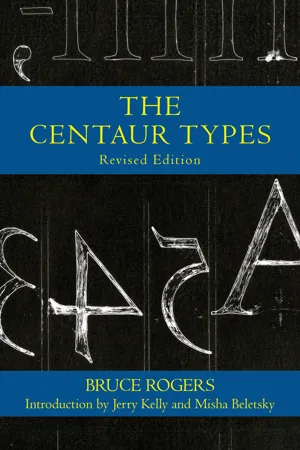![]()
CENTAUR ITS FOREBEARS, GENESIS, DEVELOPMENT & OFFSPRING.
N my early years, like other children of my age, I played with cubical blocks that had letters printed on each face. I fear I didn’t do much with them except to build houses and forts, though I may possibly have learned the alphabet at the same time—which was, of course, the intention of my elders. At any rate I was not entirely illiterate when I first went to school at the age of six, for I was put into the Second Reader class at the end of my first day in a little one-room, brick building, which was still standing (though with no tablet on it) when I last visited my home town of Linwood, in Indiana.
It was not, however, until I had reached my twelfth year, when a cousin of mine devoted to all forms of art gave me John Ruskin’s Elements of Drawing, that I became aware of letters as something more than mere units in a word. Exercise V. in that book begins: ‘When you can manage to tint and gradate tenderly with the pencil, get a good large alphabet, and try to tint the letters into shape with the pencil point.’ Ruskin was not interested primarily in letter forms—only as subjects for practice with the pencil—so I got no further information from him.
But where could I get a good large alphabet, and why should it be good as well as large? Were there, then, bad alphabets as well as good, and if so, why? No information on these matters being obtainable in the mid-western town where I then lived, the subject faded from my mind.
Later on, in college, I contributed drawings of initials and headings in the picturesque manner to several Class Annuals, and they were surely about as bad as they could be, even though John McCutcheon praised them—probably because his own were worse.
It was several years thereafter, when I had moved to Boston in the wake of J. M. Bowles’ short-lived quarterly, Modern Art, that I again became letter conscious or rather, this time, type conscious. At an exhibition of books at the Boston Public Library I saw for the first time a copy of Nicolas Jenson’s Eusebius of 1470, and I was at once impressed by the loveliness of its pages, in-differently printed though they were. This early judgment was confirmed for me many years later (though by then it needed no confirmation) when Berkeley Updike wrote of them: ‘to look at the work of Jenson is to think but of its beauty, and almost to forget that it was made with hands.’
I learned that the book belonged to William G. Shillaber, a well-known collector of that day. I called upon him at his office and explained my great interest in that particular volume and he at once kindly invited me to dine with him and examine it, and others in his library, at leisure. He offered to let me take the Jenson and photograph a page, which I did immediately; and because of the scarcity of capitals in the Eusebius I later had a photograph made of a page of the same printer’s Suetonius in the Harvard College Library, which showed nearly all of them. Thus equipped with models I began the search for what I fondly thought would be the ideally perfect type; not knowing then that it was something like the quest of the Holy Grail.
After several years of work with Houghton, Mifflin & Company, when the specially printed Riverside Press Editions had achieved a measure of success, I prevailed upon George H. Mifflin, then head of the firm and an enthusiast for good bookmaking, to let me have a new type made for a folio edition of Montaigne’s Essays then under consideration.
I had in the meantime bought Ongania’s Early Venetian Printing from Fred Melcher, who was a salesman in the book-store of Estes and Lauriat, though neither of us knew the other’s name at the time—and if we had, it would have meant nothing to us then. From Ongania I adapted several decorations for Riverside Press books, at the same time making acquaintance with other early Venetian types; but Jenson’s was still my ideal. So, with Mr. Mifflin’s kind authorization, I blithely set to work to make drawings from enlargements from my Jenson photographs. These designs, through the agency of Mr. J...



